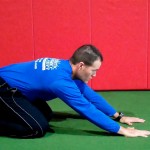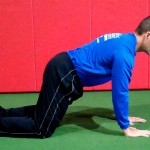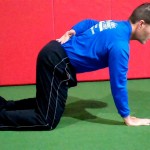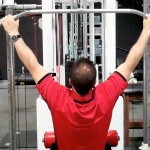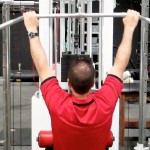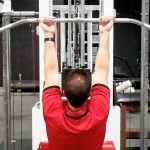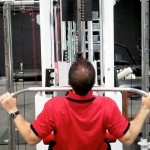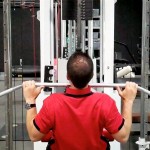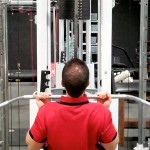Brian Schiff’s Blog
Injury Prevention, Sports Rehab & Performance Training Expert
Research along with years of observation has taught me that the brain is inherently looking for the most efficient way (aka least effort) to execute movement in life. In addition, it HATES pain just like you and I so it does everything possible to avoid it including ordering the body to perform dysfunctional movement patterns.
After a painful episode, the brain often needs reminded that the body can go back to the proper movement patterns once the pain is gone. However, it often holds that painful memory and may by default lean toward a faulty movement pattern. This protective mode then ends up perpetuating a faulty movement pattern that is no longer necessary nor efficient. Over time, dysfunctional movement patterns can create further stress or harm to other segments in the kinetic chain.
So, I am always seeking ways to stimulate the body to work properly and exercises that facilitate proper neuromuscular patterning are instrumental in my rehab and training. I wanted to share two exercises that I like to utilize in my rehab and training for the shoulder. In particular, I like to employ closed chain activity to stimulate the serratus anterior as well as the other scapular stabilizers.
Below are two exercises I wrote about in my “Functionally Fit” column for PFP magazine. The first exercise shows quadruped rocking. Shirley Sahrmann mentions this in her work, Diagnosis and Treatment of Movement Impairment Syndromes. I began using it after reading her book, and I agree that it works very well for scapular dysfunction. Below is the start and finish position for the quadruped version as well as my own advanced tripod version of the exercise.
- Quadruped start
- Quadruped finish
- Tripod finish
For a complete explanation of the exercise and its application, click here to read the column.
As a follow-up to this exercise, I included an unstable progression I like to employ using the BOSU trainer. I call this the unstable tripod scapular clock. It can be done on the knees or up on the toes. I have included a quick video on this below. Again, I like this exercise for scapular work as well as core stability training.
Click here to read my PFP column on this exercise for the full description, application and regressions. The real beauty of this last exercise is the “big bang for your buck” attributes since it hits shoulder, core and hip stability all at once for those able to work at that level. I hope it works as well for you as it has for me!
One of the most common issues I see in the clinic with active exercise enthusiasts between the age of 20 and 55 is shoulder pain. Weightlifting has been popular for ages, but Crossfit is all the rage these days. Both disciplines involve overhead lifts. The key thing to remember when performing overhead repetitive lifts is how load and stress not only affects strength and power, but how it impacts the joint itself.
Pull-ups and pull-downs are staples for most clients I see. As a therapist and strength coach, I am always thinking and analyzing how variables such as grip, grip width, arm position, scapular activation, trunk angles etc influence exercise and how force is absorbed by the body. One such exercise I have spent time studying and tweaking is the lat pull-down.
Consider for a moment how width and grip impacts the relative abduction and horizontal external rotation in the shoulder at the top and bottom of the movement in the pictures below (start and finish positions are vertically oriented):
It should be common knowledge for most, but I will state it for the record anyway – you should NEVER do behind the neck pull-downs. Beyond the horrible neck position, this places the shoulder in a dangerous position for impingement and excessively stresses the anterior shoulder capsule. A wider grip (be it with pull-ups, pull downs, push-ups) will always transfer more stress to the shoulder joint because you have a longer lever and greater abduction and horizontal external rotation.
So, what bearing does this have in relation to the rotator cuff and SLAP injuries? For more information and details on the application of the grip choice, click here to read the full column I did for PFP Magazine this month. Stay tuned for my next post (a follow-up to this one) one of my Crossfit patients who now only has pain with overhead squats and how my differential diagnosis and rehab has led me to conclude what is wrong with his shoulder. Keep in mind we must learn to train smarter so we can train harder and longer without pain and injury. Biomechanics and understanding your own body really does matter.
By far the most common problem I see in the clinic is shoulder pain. Most of the time it is related to overuse, rotator cuff tendonitis/impingement and labral tears. Because we are geared more toward sports rehab, I also treat a lot of overhead athletes (baseball players, volleyball players and swimmers).
A common thing I will see in those suffering from impingement or rotator cuff pain is scapular winging. Most of the time the muscle is simply deficient in strength/endurance and it along with the lower trap become overpowered by the upper trap, levator or even the rhomboids. Shortened scapulohumeral muscles, poor posture and pec tightness can also impact winging.
There are many traditional exercises such as serratus punches, push-ups with a plus, and serratus plank push-ups to name a few, but I wanted to include a closed chain exercise that can be very effective for facilitating proper activation of the serratus – quadruped rocking.
In the video, I show it with both hands fixed on the floor progressing to one hand (on the involved side). The key is quality of movement throughout. After you check out the video, be sure to scroll down and click the link to a full column I wrote for PFP magazine on this exercise as it further explains the technique and application.
Click here to read the online column for PFP Magazine.
One of my favorite tools I use in the gym with my clients is the BOSU. Admittedly, it is really easy to get carried away with various tools and equipment when training clients or ourselves. But, the BOSU is awesome if you are into building strong stable shoulders and safeguarding them against injury.
Many people focus on open chain (the hand is free in space) shoulder training, but in overhead athletes such as swimmers, volleyball players and throwers, it is essential to build a solid level of scapular strength to absorb force and enable the shoulder to move freely and effectively generate power.
I routinely include BOSU stability work in the following ways:
- Dynamic warm-up
- Core training
- Upper body work & scapular strengthening
One of my favorite exercises is what I term the “BOSU clock.” I wrote a column on this exact exercise for PFP Magazine a few months back.

Click here to read more and learn how to use this exercise to improve shoulder stability and reduce pain and/or injury risk related to shoulder instability, rotator cuff pathology and muscular imbalances.
This is just one great way to use the BOSU in your training. If you are interested in getting your very own BOSU, head on over to my OpenSky Shop and check it out – http://brianschiff.theopenskyproject.com/
Lately, I have been working with an elite swimmer hoping to make it to the 2012 Olympics in London. It has been blast training her since she is so fit, driven and willing to embrace training with a smile each session. I mean seriously, how many 16 year olds do you know that swim 5 hours per day, go to school, and train with someone like me 3x/week?
While I utilize many common exercises in her program, I definitely pepper in several ones aimed at maximizing core and shoulder strength/stability. One of the exercises I use from time to time with her is a shoulder glide exercise. I thought I would share this little gem today.
This is NOT an exercise I recommend for people with shoulder impingement, recurrent instability, poor shoulder mobility or those lacking a high level of fitness to begin with. In other words, this is no sissy exercise and it can be dangerous if used improperly.
To start with, I had my swimmer do it with both hands. Once she demonstrated the right form with ease, we progressed to this version in the video below:
So, if you are looking for a great way to challenge and improve shoulder and core strength, this is one to add to your arsenal. Be wary of gliding out too fast as this is a sign your upper body and/or core is not strong enough to decelerate the motion effectively. The pull back motion is a great way to strengthen the lats and swimming muscles as well, all the while exposing and resolving any single sided deficiencies.

